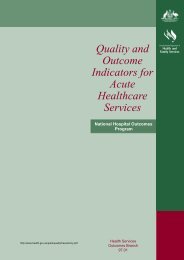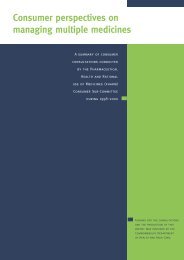The Pharmaceutical Price Regulation Scheme - Office of Fair Trading
The Pharmaceutical Price Regulation Scheme - Office of Fair Trading
The Pharmaceutical Price Regulation Scheme - Office of Fair Trading
Create successful ePaper yourself
Turn your PDF publications into a flip-book with our unique Google optimized e-Paper software.
February 2007<br />
3.43 Financial factors, such as labour costs, taxation rates and tax credits, also have an impact<br />
but are generally held by industry to be <strong>of</strong> secondary importance to the ‘quality’ <strong>of</strong> the<br />
investment environment (that is, to be determinative only when countries are equally<br />
attractive on quality grounds).<br />
3.44 <strong>The</strong> UK performs particularly well against many factors relating to the quality <strong>of</strong> the<br />
investment environment, enjoying large numbers <strong>of</strong> highly qualified scientists and, perhaps<br />
most importantly, highly regarded experts in the medical or pharmaceutical fields – or ‘opinion<br />
leaders’ – who are key to encouraging companies to conduct clinical trials in the UK. Through<br />
spillover effects, public expenditure on R&D can also help attract private investment. Here<br />
again, the UK performs impressively: the proportion <strong>of</strong> GDP spent on public health R&D in<br />
the UK is the second highest in the world (after the US). <strong>The</strong> recent Cooksey Review 30 has<br />
made recommendations for how a new single fund for health research – worth an estimated<br />
£1bn – might be operated in the future.<br />
3.45 <strong>The</strong>se and other factors discussed in Annexe E help explain the UK’s success to date in<br />
attracting private sector R&D expenditure. Some companies also suggested to us that<br />
‘market conditions’ were important in determining where investments will take place.<br />
However, it is not clear to us how there can be an explicit link. By definition, the revenues<br />
companies receive from the sales <strong>of</strong> products in a particular market are not a driver <strong>of</strong><br />
internationally mobile investments – only <strong>of</strong> market specific expenditure such as marketing –<br />
since companies are not required to invest in a particular country to receive revenues from<br />
selling a particular product. 31<br />
3.46 In response, it has been suggested to us that there is an indirect link between price and the<br />
location <strong>of</strong> investment, since companies will use the threat <strong>of</strong> withdrawing investments as a<br />
means <strong>of</strong> persuading governments to maintain high prices. It is rational for companies to<br />
make such threats in an attempt to make features <strong>of</strong> the policy environment – such as pricing<br />
and reimbursement decisions – more favourable. It is not clear, however, that these threats<br />
are always credible, particularly if the country in question performs strongly in relation to the<br />
drivers identified above. We could find no clear relationship between price level and success<br />
in attracting R&D investment.<br />
3.47 Overall, our findings are consistent with the high level conclusions <strong>of</strong> a forthcoming report<br />
jointly commissioned by UKTI and ABPI under the auspices <strong>of</strong> the Ministerial Industry<br />
Strategy Group (MISG) 32 which reported:<br />
“In general, we did not find credible economic mechanisms to suggest that product<br />
market characteristics were <strong>of</strong> over-riding importance when making investment decisions.<br />
Firms should locate research and manufacturing in the best and most cost-efficient<br />
locations, then market their products globally.<br />
3.48 <strong>The</strong> NERA report went on to say,<br />
“However, we found that firms <strong>of</strong>ten have a number <strong>of</strong> alternative locations for investment<br />
assets that are broadly equal in other dimensions, and in these situations market<br />
conditions can be an influence on the ultimate choice.”<br />
We are not convinced <strong>of</strong> this argument but consider its implications at the end <strong>of</strong> this chapter.<br />
30 A Review <strong>of</strong> UK Health Research Funding (2006), Sir David Cooksey December 2006.<br />
31 <strong>The</strong>re is one component <strong>of</strong> R&D for which it could be argued that decisions over where to locate are related in part to<br />
market conditions. <strong>The</strong> location <strong>of</strong> clinical trials may in part be driven by a desire to market a product to clinicians in a<br />
particular country so as to improve subsequent uptake.<br />
32 NERA (Forthcoming 2007), ‘Key Factors in Attracting Internationally Mobile Investments by the Research-Based<br />
<strong>Pharmaceutical</strong> Industry’, a report commissioned by UKTI and ABPI and presented to the MISG. Henceforth referred to as<br />
‘the NERA report’.<br />
47




